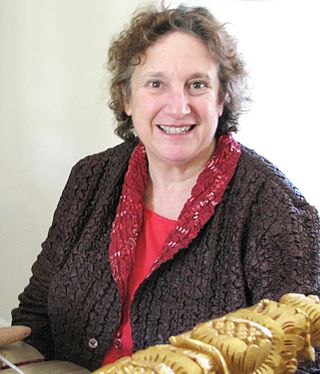Related Research Articles

Gamelan is the traditional ensemble music of the Javanese, Sundanese, and Balinese peoples of Indonesia, made up predominantly of percussive instruments. The most common instruments used are metallophones and a set of hand-drums called kendang, which keep the beat. The kemanak, a banana-shaped idiophone, and the gangsa, another metallophone, are also commonly used gamelan instruments on Bali. Other notable instruments include xylophones, bamboo flutes, a bowed string instrument called a rebab, and a zither-like instrument called a siter, used in Javanese gamelan. Additionally, vocalists may be featured, being referred to as sindhen for females or gerong for males.

The School of Music, Theatre, and Dance is the undergraduate and graduate school for the performing arts of the University of Michigan, in Ann Arbor, Michigan, United States.

Mantle Hood was an American ethnomusicologist. Among other areas, he specialized in studying gamelan music from Indonesia. Hood pioneered, in the 1950s and 1960s, a new approach to the study of music, and the creation of the first American university program devoted to ethnomusicology, at the University of California, Los Angeles (UCLA). He was known for a suggestion, somewhat novel at the time, that his students learn to play the music they were studying.

A kempul is a type of hanging gong used in Indonesian gamelan. The kempul is a set of pitched, hanging, knobbed gongs, often made of bronze, wood, and cords. Ranging from 19 cm to 25,4 cm in diameter, the kempul gong has a flat surface with a protruding knob at the center and is played by hitting the knob with the "soft end of a mallet." "The wooden mallet used has a ball shape head with heavy padding on a short wooden handle. The number of kempul gongs present in a gamelan ensemble varies but, "although there can be two to ten kempul on one separate rack, it is common to have five kempul hanging on the same rack as the Gong ageng and gong siyem".

Jody Diamond is an American composer, performer, writer, publisher, editor, and educator. She specializes in traditional and new music for Indonesian gamelan and is active internationally as a scholar, performer, and publisher.

The gong ageng is an Indonesian musical instrument used in the Javanese gamelan. It is the largest of the bronze gongs in the Javanese and Balinese gamelan orchestra and the only large gong that is called gong in Javanese. Unlike the more famous Chinese or Turkish tam-tams, Indonesian gongs have fixed, focused pitch, and are dissimilar to the familiar puke crash cymbal sound. It is circular, with a conical, tapering base of diameter smaller than gong face, with a protruding polished boss where it is struck by a padded mallet. Gongs with diameter as large as 135 centimeters have been created in the past, but gongs larger than about 80 centimeters are more common especially to suit the budget of educational institutions.
Imbal or imbalan is a technique used in Indonesian Javanese gamelan. It refers to a rapid alternation of a melodic line between instruments, in a way similar to hocket in medieval music or kotekan in Balinese gamelan. "A style of playing in which two identical or similar instruments play interlocking parts forming a single repetitive melodic pattern."
This imbal is a method of playing in which the nuclear theme is played by one of the nyaga's 'broken up' into half-values, what time another player beats alternately with the first, but in such a way that his tones, each of which comes between two of his colleague's, are always one step lower than the nuclear theme tone immediately preceding it. From practical considerations this imbal is, if possible, divided over two demungs; if only one such instrument is available, the two players sit facing each other. The player who beats the nuclear theme tones is said to play the gawé (...); the other one, the nginţil (...).

Jaap Kunst was a Dutch musicologist. He is credited with coining the term "ethnomusicology" as a more accurate name for the field then known as comparative musicology. Kunst studied the folk music of the Netherlands and of Indonesia. His published work totals more than 70 texts.

Kanjeng Pangeran Harjo Notoprojo, also known as Tjokrowasito, Wasitodipuro, Wasitodiningrat, among other names, was one of the most highly respected performers of Javanese gamelan. He led the Paku Alaman palace gamelan as well as the gamelan for the Radio Republik Indonesia Yogyakarta, and taught gamelan in universities around the world. He was also a noted composer and rebab performer.

The bedhaya is a sacred, ritualised Javanese dance of Java, Indonesia, associated with the royal palaces of Yogyakarta and Surakarta. Along with the srimpi, the bedhaya epitomized the elegant character of the royal court and became an important symbol of the ruler's power.
Sumarsam is a Javanese musician and scholar of the gamelan.
Sean Williams is an ethnomusicologist who teaches at The Evergreen State College in Olympia, Washington.

Sociomusicology, also called music sociology or the sociology of music, refers to both an academic subfield of sociology that is concerned with music, as well as a subfield of musicology that focuses on social aspects of musical behavior and the role of music in society.
Raden Machjar Angga Koesoemadinata, known as Pak Machjar or Pak Mahyar, was a Sundanese music composer and an Indonesian musicologist, specializing in pelog and salendro. He invented the Sundanese solfège system and the Sundanese 17-tone model. He was born in Sumedang on 7 December 1902, and died in Bandung on 9 April 1979.

Julien Tiersot, was a French musicologist, composer and a pioneer in ethnomusicology.

Gandrung is a traditional dance from Indonesia. Gandrung has many variations and is popular in Bali, Lombok, and Eastern Java among the Balinese, Sasak, and Javanese. The most popular variation is gandrung from the Banyuwangi region in the eastern peninsula of Java; thus, the city is often referred to as Kota Gandrung, or "the city of gandrung". Originally a ritual dance dedicated to the goddess of rice and fertility, Dewi Sri, it is currently performed as a social dance of courtship and love in communal and social events, or as a tourist attraction. Gandrung Sewu Festival is held at Banyuwangi annually.

Sundanese dances is a dance tradition that is a part of ritual, artistic expression as well as entertainment and social conduct among the Sundanese people of West Java and Banten, Indonesia. Sundanese dance is usually cheerful, dynamic and expressive, with flowing movements in-sync with the beat of kendang accompanied with Gamelan degung music ensemble.

Alton L. (Pete) Becker was an American linguist known for his studies of Burmese grammar and other Southeast Asian languages, including Malaysian, Javanese and Kawi. He was a professor of linguistics at the University of Michigan from 1968 to 1986. Becker published studies in philology, rhetoric, and the ethnography of communication. He was coauthor with Richard E. Young and Kenneth L. Pike of the widely influential college writing textbook, Rhetoric: Discovery and Change, which introduced a Rogerian framework for communication and rhetoric studies as an alternative to the Aristotelian approach. To recognize his significant contributions and publications of translations from Southeast Asian languages to English, the Association for Asian Studies awards the annual A. L. Becker Prize to honor his significant contributions.
William Malm is an American musicologist known for his studies of Japanese traditional music. As a composer, teacher, and scholar of Japanese music, Malm shaped the study of ethnomusicology in the United States. Malm authored the first major scholarly study in English of the history and instruments of Japanese music, Japanese Music and Musical Instruments (1959). He was a faculty member at the University of Michigan from 1960 to 1994. Malm served as president of the Society for Ethnomusicology from 1977 to 1979 and was named an Honorary Member of that organization in 2004. Malm was awarded the Fumio Koizumi Prize in 1992 for his contributions to the study of Japanese music. As the 2001 Charles Seeger Lecturer, Malm's address focused on the history and founding of ethnomusicology in the United States.
Margaret Joy Kartomi is an Australian ethnomusicologist who is known especially for her contributions to the study of Asian music. She is an emeritus professor of Monash University in Melbourne. She specialises in the music of Indonesia and Southeast Asia.
References
- 1 2 Terry E. Miller, "Becker, Judith O." in the New Grove Dictionary of Music and Musicians (2001).
- ↑ "Biography of Judith Becker". Society for Ethnomusicology. Retrieved August 1, 2013.
- ↑ "Senior Fellows, Society of Fellows". University of Michigan. Retrieved 31 March 2014.
- ↑ Interview with Judith Becker by R. Anderson Sutton, Newsletter of the Society for Ethnomusicology, vol. 47, no. 2 (March 2013), http://c.ymcdn.com/sites/www.ethnomusicology.org/resource/resmgr/newsletters/semnl47-2.pdf (accessed January 2014).
- ↑ Sarah E. Fike (March 2008). "Oral history interview with Judith Becker (transcript)". Living Music, University of Michigan. Archived from the original on 2011-08-03. Retrieved 2020-02-09.
- ↑ "Charles Seeger Lecturers". Society for Ethnomusicology. Retrieved January 1, 2014.
- ↑ "Alan Merriam Prizewinners" . Retrieved 11 August 2013.
- ↑ "Honorary Members". Society for Ethnomusicology. Retrieved May 20, 2024.